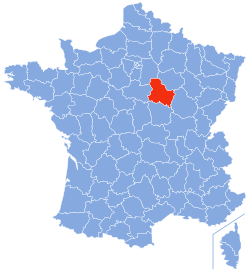Department of Yonne
| Yonne | ||
|---|---|---|
| Department | ||

Prefecture building of the Yonne department, in Auxerre
|
||
|
||
 Location of Yonne in France |
||
| Coordinates: 47°48′N 3°34′E / 47.800°N 3.567°ECoordinates: 47°48′N 3°34′E / 47.800°N 3.567°E | ||
| Country | France | |
| Region | Bourgogne-Franche-Comté | |
| Prefecture | Auxerre | |
| Subprefectures |
Avallon Sens |
|
| Government | ||
| • President of the General Council | Jean-Marie Rolland | |
| Area | ||
| • Total | 7,427 km2 (2,868 sq mi) | |
| Population (2013) | ||
| • Total | 341,483 | |
| • Rank | 69th | |
| • Density | 46/km2 (120/sq mi) | |
| Time zone | CET (UTC+1) | |
| • Summer (DST) | CEST (UTC+2) | |
| Department number | 89 | |
| Arrondissements | 3 | |
| Cantons | 21 | |
| Communes | 428 | |
| ^1 French Land Register data, which exclude estuaries, and lakes, ponds, and glaciers larger than 1 km2 | ||
Yonne (French pronunciation: [jɔn]) is a French department named after the river Yonne. It is one of the eight constituent departments of Bourgogne-Franche-Comté and is located in the northwest of the region, bordering Île-de-France. It was created in 1790 during the French Revolution. Its prefecture (capital) is Auxerre and its postcode number is 89.
It is the fourth most populous department in the region with a population of about 342,000 (2012), and an average annual increase over the last few years of 0.41% per year. The biggest city is Auxerre, the capital, with a population of 35,000 in the city and roughly 43,000 in the urban area centred on it.
The first evidence of occupation in this area is found in the Grottes d'Arcy-sur-Cure where paintings have been found dating back 28,000 years. The Palaeolithic hunter-gatherers of that time also left behind numerous flint artefacts, but the area is believed to have been occupied for about 200,000 years. By 4000 BC, a wave of Neolithics arrived from the Danube region of eastern Europe building substantial wooden houses and introducing pottery decorated with the characteristics of the Linear Pottery culture. Further waves of immigrants followed, the Chasséen culture, and the Michelsberg culture.
The Celtic tribe in the area were named "Icauna", after the River Yonne which they thought sacred, and the region was later occupied by Gallic tribes. The area then came under the control of the Romans, whose chief town was Sens, which they called Agendicum. It was the capital of their province of Gallia Lugdunensis, one of four provinces into which France was subdivided. The present main roads from Lyon to Boulogne, and from Sens to Alise-Sainte-Reine date from this period. About this time, Auxerre, Tonnerre (Tornodurum) and Avallon were growing in size and in the fourth century, Sens became a walled city, and the first bishops were appointed in Sens and Langres whose power was to influence the region profoundly.
...
Wikipedia

